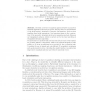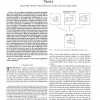883 search results - page 69 / 177 » Face Recognition Based on 2D and 3D Features |
106
click to vote
ECCV
2004
Springer
16 years 1 months ago
2004
Springer
Recently, a 3D face recognition approach based on geometric invariant signatures, has been proposed. The key idea is a representation of the facial surface, invariant to isometric ...
IROS
2006
IEEE
15 years 6 months ago
2006
IEEE
This work is about the relevance of Gibson’s concept of affordances [1] for visual perception in interactive and autonomous robotic systems. In extension to existing functional ...
TEC
2002
14 years 11 months ago
2002
We investigate the application of genetic algorithms (GAs) for recognizing real two-dimensional (2-D) or three-dimensional (3-D) objects from 2-D intensity images, assuming that th...
92
Voted
EDUTAINMENT
2006
Springer
15 years 3 months ago
2006
Springer
In this paper we describe a framework for generating 3D paper-cutting effects on mesh models. The framework involves the construction of model defined paper-cutting patterns, extr...
109
click to vote
SSPR
2004
Springer
15 years 5 months ago
2004
Springer
We focus on characterizing spatial region data when distinct classes of structural patterns are present. We propose a novel statistical approach based on a supervised framework for...


